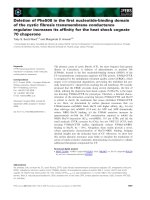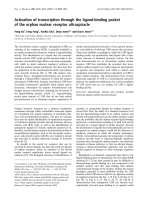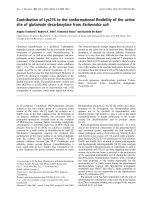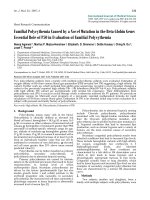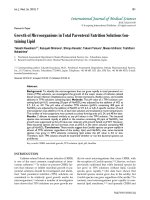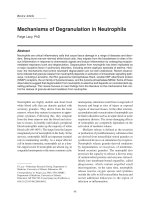Báo cáo y học: "Usefulness of procalcitonin for diagnosis of sepsis in the intensive care unit" doc
Bạn đang xem bản rút gọn của tài liệu. Xem và tải ngay bản đầy đủ của tài liệu tại đây (57.51 KB, 6 trang )
Available online />Research
Usefulness of procalcitonin for diagnosis of sepsis
in the intensive care unit
Canan BalcI
1
, Hülya Sungurtekin
2
, Ercan Gürses
3
, Ug
v
ur Sungurtekin
4
and Bünyamin Kaptanog
v
lu
5
1
Specialist, Department of Anesthesiology and Reanimation, Pamukkale Unversity School of Medicine, Denizli, Turkey
2
Associate Professor, Department of Anesthesiology and Reanimation, Pamukkale Unversity School of Medicine, Denizli, Turkey
3
Assistant Professor, Department of Anesthesiology and Reanimation, Pamukkale Unversity School of Medicine, Denizli, Turkey
4
Professor, Department of General Surgery, Pamukkale Unversity School of Medicine, Denizli, Turkey
5
Associate Professor, Department of Biochemistry, Pamukkale Unversity School of Medicine, Denizli, Turkey
Correspondence: Hülya Sungurtekin,
Introduction
The term ‘sepsis’ is used to define the systemic inflammatory
response to an infectious agent (i.e. bacterial, viral, fungal or
parasitic). Despite the use of new treatment modalities,
improvements in technology and increased experience, mor-
tality rates in sepsis remain high [1,2]. Critical care physicians
have at their disposal a variety of data to serve as a guide in
discriminating infectious from noninfectious conditions in
newly admitted patients. In a number of newly admitted
patients the diagnosis of sepsis becomes clear after taking
the medical history and completing the physical examination
85
APACHE = Acute Physiology and Chronic Health Evaluation; AUC = area under the receiver operating characteristic curve; CRP = C-reactive
protein; ICU = intensive care unit; IL = interleukin; PCT = procalcitonin; SIRS = systemic inflammatory response syndrome; TNF = tumour necrosis
factor.
Abstract
Introduction The diagnosis of sepsis in critically ill patients is challenging because traditional markers
of infection are often misleading. The present study was conducted to determine the procalcitonin level
at early diagnosis (and differentiation) in patients with systemic inflammatory response syndrome
(SIRS) and sepsis, in comparison with C-reactive protein, IL-2, IL-6, IL-8 and tumour necrosis factor-α.
Method Thirty-three intensive care unit patients were diagnosed with SIRS, sepsis or septic shock, in
accordance with the American College of Chest Physicians/Society of Critical Care Medicine
consensus criteria. Blood samples were taken on the first and second day of hospitalization, and on
the day of discharge or on the day of death. For multiple group comparisons one-way analysis of
variance was applied, with post hoc comparison. Sensitivity, specificity and predictive values for PCT
and each cytokine studied were calculated.
Results PCT, IL-2 and IL-8 levels increased in parallel with the severity of the clinical condition of the
patient. PCT exhibited a greatest sensitivity (85%) and specificity (91%) in differentiating patients with
SIRS from those with sepsis. With respect to positive and negative predictive values, PCT markedly
exceeded other variables.
Discussion In the present study PCT was found to be a more accurate diagnostic parameter for
differentiating SIRS and sepsis, and therefore daily determinations of PCT may be helpful in the follow
up of critically ill patients.
Keywords C-reactive protein, cytokine, diagnosis, procalcitonin, sepsis
Received: 10 June 2002
Revisions requested: 31 July 2002
Revisions received: 28 August 2002
Accepted: 5 October 2002
Published: 30 October 2002
Critical Care 2003, 7:85-90 (DOI 10.1186/cc1843)
This article is online at />© 2003 Balc
I et al., licensee BioMed Central Ltd
(Print ISSN 1364-8535; Online ISSN 1466-609X). This is an Open
Access article: verbatim copying and redistribution of this article are
permitted in all media for any non-commercial purpose, provided this
notice is preserved along with the article's original URL.
Open Access
86
Critical Care February 2003 Vol 7 No 1 Balc
I
et al.
[3]. In other cases, in which noninfectious insults are respon-
sible for systemic inflammatory response syndrome (SIRS;
e.g. trauma, burns, haemorrhages, hypothermia, pancreatitis
and surgery) or in comatose patients, the diagnosis of sepsis
remains difficult.
Prompt diagnosis and treatment with appropriate antimicro-
bial chemotherapy is of the utmost importance in reducing
the morbidity and mortality associated with sepsis. The lack
of specific early markers of infection may be responsible in
part for withholding of, or delaying or unnecessary antimicro-
bial treatment in critically ill patients [4]. Thus, there is an
unmet need for clinical or laboratory tools that can distinguish
between SIRS and sepsis. Various markers of sepsis, includ-
ing C-reactive protein (CRP), tumour necrosis factor (TNF)-α,
IL-1β, IL-6 and IL-8, have all been studied for their ability to
differentiate SIRS from sepsis [4–7]. Several investigators
have questioned the diagnostic accuracy of procalcitonin
(PCT) measurement, results with which have been inconsis-
tent and variable [4,6–10]. Thus, it may not be easy to dis-
criminate between SIRS and sepsis, even with the use of
PCT.
The present study was conducted to determine the PCT level
at early diagnosis (and differentiation) in patients with SIRS
and sepsis, in comparison with CRP, IL-2, IL-6, IL-8 and
TNF-α in an unselected population of patients suffering from
a broad range of diseases in an intensive care unit (ICU).
Method
The study was approved by the Institutional Ethics Commit-
tees of the Pamukkale University Medical School. Written
informed consent was obtained from all patients or their rela-
tives before enrollment. Over a 6-month period, all patients
staying for more than 24 hours in the ICU were consecutively
enrolled in the study. Patients who had chronic organ failure,
thyroid cancer or pancreatitis; who had received massive
blood transfusion; or whose anticipated duration of stay was
under 24 hours were excluded from the study.
At admission, the patient’s age, sex, height and weight were
recorded. Also, data were collected at admission, on day 2,
and on the day of discharge or on the day of death. These
data included the following: clinical status (SIRS, sepsis or
septic shock); Acute Physiology and Chronic Health Evalua-
tion (APACHE)-II score; temperature; heart rate; respiratory
rate; blood pressure; central venous pressure; laboratory
analysis (complete blood count, blood urea nitrogen, blood
sugar, serum sodium, potassium and calcium, aspartate
aminotransferase, alanine aminotransferase, prothrombin time,
activated partial thromboplastin time, albumin, transferrin and
CRP); and arterial blood gas analysis. The final determination
of the patient’s status was done retrospectively, without
knowledge of plasma cytokine and PCT levels, on the basis of
the complete patient charts, results of microbiological cul-
tures, chest radiographs and ultrasound, when available.
Blood samples were centrifuged at 1500 g for 5 min (Rotina
35; Cheftich Zentrifugen, Hennigsdorf, Berlin, Germany), and
serum for cytokine and PCT determination was collected in
sterile tubes. Serum samples were stored at –30°C until
assayed in Nu-6511E (Nuare, Tokyo, Japan). The treating
clinicians were blinded to the PCT results, and those per-
forming the PCT assays were blinded to the clinical status of
the patient. The PCT results were not available during the
study period. Routine cultures of blood and urine, and of
samples from trachea and suspected sites were obtained to
identify the organisms present and determine the degree of
antibiotic resistance.
We attempted to maintain the patients’ haemoglobin level at
10–12 g/dl and central venous pressure at 8–12 mmHg in
the ICU. If needed, blood products, intravascular fluid
replacement, and inotropic and/or vasopressor agents were
administered.
The American College of Chest Physicians/Society of Critical
Care Medicine consensus classification was used for diagno-
sis of SIRS, sepsis and septic shock [11]. Patients were
assessed for the presence of infection at admission, on day 2,
and on the day of discharge or on the day of death. Clinical
assessment was the first step in diagnosing infection. Cultures
of urine, blood and tracheal aspirates were taken for diagno-
sis. Respiratory tract infection was assessed according to
chest radiography and the presence or absence purulent tra-
cheal aspirates containing micro-organisms. Intra-abdominal
infection was suspected in the presence of contaminated or
dirty surgical sites, and wound swabs were taken and ultra-
sound performed in such cases. Colonization was defined as
microbiological evidence with no host response.
Laboratory measurements
CRP was measured using a routine turbidimetry assay (ILAD-
900; Instrumentation Laboratory, Milan, Italy); a value greater
than 10 mg/l was considered to be abnormally elevated.
TNF-α, and IL-2, IL-6 and IL-8 were measured using commer-
cially available cheluminescence kits (Immulite-One; DTC,
Los Angeles, CA, USA). All cytokine samples were analyzed
in duplicate. PCT levels (normal range 0–0.5 ng/l) were
determined by means of a specific and ultrasensitive immuno-
luminometric assay (LUMI test PCT; Brahms Ag, Hennigs-
dorf/Berlin, Germany).
Statistical analysis
For multiple group comparisons of CRP, ILs and PCT, one-
way analysis of variance was applied, with least squares dif-
ference for post hoc comparison. The best cutoff value of
parameters for the diagnosis of sepsis was determined
according to the Youden’s index method. The ability of PCT
to predict sepsis was evaluated by performing receiver oper-
ating characteristic analyses to compare SIRS versus sepsis
patients [12]. Furthermore, the areas under the receiver oper-
ative characteristic curve (AUCs) were determined, as well as
87
the positive/negative predictive values. Positive predictive
values and negative predictive values indicate the proportion
of patients with a cytokine level greater than or below the
chosen cutoff point. Test effectiveness is the sum of the posi-
tive predictive values and negative predictive values. Thus,
the maximum score is 2, which represents perfect prediction,
both positive and negative [13]. The septic shock group was
not included in this analysis because of insufficient data. Sta-
tistical analyses were conducted using the Statistical
Program for Social Science (SPSS, Chicago, IL, USA).
P < 0.05 was considered statistically significant. Data in the
text are shown as mean ± standard error, or as median and
percentiles (10%/25%/75%/90%).
Results
A total of 33 patients (17 men and 16 women) were included
in the study. The median age of the patients was
58 ± 16 years. The duration of stay of the patients in the ICU
was 7.4 ± 6.78 days. The final, retrospectively confirmed
diagnoses of all patients are shown in Table 1.
For each of the time points assessed in the present study,
patients were categorized into the three groups, namely
SIRS, sepsis and septic shock. No severely septic patients
were identified. Ten patients died on the second day follow-
ing admission to the ICU, and those patients underwent only
two assessments. Thus, a total of 89 assessments of the
patients’ clinical status were conducted (referred to hereafter
as ‘conditions’), 48 of which indicated SIRS (53% of all
patients), 35 sepsis (39% of all patients) and 6 septic shock
(7% of all patients).
Of the 41 conditions of sepsis and septic shock, 24 (58%)
involved pneumonia, 8 (20%) urogenital infection, 2 (5%)
intraperitoneal abscess and 5 (12%) wound infection. In
three patients no infectious focus could be found, but blood
cultures were positive. Infections were microbiologically
proven in 36 (88%) conditions, with 51% being Gram-nega-
tive, 41% Gram-positive and 8% mixed infections. Of the five
conditions with SIRS, tracheal cultures were positive but did
not exhibit any host response; they were therefore considered
colonization. Eight patients did not receive antimicrobial treat-
ment in any of the study periods. Five of the patients who
died (5/6 [83%]) were in septic shock group and the other
five patients who died (5/35 [14%]) were in the sepsis group.
APACHE-II scores did not differ between groups. No correla-
tion was found between PCT concentrations and APACHE-II
scores (r = 0.23). Serum concentrations of CRP, TNF-α and
IL-6 were not statistically different between SIRS, sepsis and
septic shock groups. IL-2, IL-8 and PCT levels were different
between groups. Septic shock patients had the highest level
of IL-2, IL-8 and PCT concentrations. Median and percentiles
(10/25/75/90%) for all parameters and APACHE-II scores in
patients with SIRS, sepsis and septic shock are presented in
Table 2.
Because only six septic shock conditions were identified, we
employed only SIRS and sepsis conditions for statistical
analysis of diagnostic reliability of serum PCT and cytokines.
Using Youden’s Index, the best cutoff value for PCT was
2.415 ng/ml. The best cutoff value and AUC for all markers
are shown in Table 3. The AUC was highest for PCT. Table 4
summarizes the predictive accuracy of the laboratory vari-
ables for the specific diagnoses of SIRS and sepsis. With a
cutoff point of 2.415 ng/ml, serum PCT concentration was
found to be the most discriminatory laboratory variable, the
predictive accuracy of which exceeded those of CRP, TNF-α,
IL-2, IL-6 and IL-8. With regard to positive and negative pre-
dictive values, we found that PCT markedly exceeds the
values calculated for other variables. The test effectiveness
was 1.84 for PCT in predicting sepsis, whereas the other
variables reached values between 0.96 and 1.22.
Discussion
We analyzed the plasma concentrations of various biochemi-
cal markers with respect to their potential use in differentiat-
ing between patients suffering from SIRS and those suffering
from sepsis. This assessment is of potential interest because
systemic inflammation is a common problem in the ICU,
which often leads to shock and death. The diagnostic reper-
toire for identifying SIRS is poor. Verification of infection site,
and even the presence of infection, remains problematic in
sepsis. In 20–30% of patients, the infection site is never iden-
tified. Neither imaging studies nor blood culture analysis can
rule out the presence of infection [14]. Moreover, there are
classes of patients with unconfirmed infection, or for whom
cultures are negative yet who develop similar symptoms,
rates of organ failure and survival outcomes as do those
patients in whom infection is confirmed. The availability of lab-
Available online />Table 1
Clinical diagnoses of the patients
Diagnosis Number of patients
Medical 13
Respiratory insufficiency 6
Neurological disease 5
HELLP syndrome 1
Gastrointestinal haemorrhage 1
Surgical 20
Gastrointestinal surgery 12
Polytrauma 2
Orthopaedic surgery 4
Thoracic surgery 1
Urological surgery 1
HELLP, haemolysis–elevated liver enzymes–low platelets.
88
oratory tests for accurate and rapid identification of septic
patients by isolation of micro-organisms from body fluid spec-
imens would be of considerable value. Thus, there is a clear
need for a reliable diagnostic procedure that allows early dis-
crimination between patients suffering from SIRS and those
with sepsis. A relatively new marker that has been associated
with inflammation and sepsis is PCT, a 116-amino-acid
protein that is the precursor to calcitonin. The PCT plasma
level in healthy individuals is low, usually below 0.1 ng/ml
[15]. That PCT concentration is significantly elevated in
patients with organ dysfunction is undoubted. However, the
difference in PCT between patients with SIRS and those with
sepsis may be small. Reports of the usefulness of PCT for
discriminating between SIRS and sepsis are conflicting
[4,6–10]. Therefore, we selected several cytokines as well as
PCT for early diagnosis (and differentiation) of patients with
SIRS and sepsis.
High serum PCT concentrations were first described by
Assicot and coworkers [16] in children with severe bacterial
infections, and were suggested to be a specific marker for
bacterial infection. Al-Nawas and coworkers [17] reported
Critical Care February 2003 Vol 7 No 1 Balc
I
et al.
Table 3
Best cutoff and AUC value of laboratory parameters in predicting of sepsis
Parameter Best cutoff AUC (mean ± SE) P value
CRP (mg/dl) 14.5 0.554 ± 0.062 0.378
TNF-α (pg/ml) 11.5 0.607 ± 0.06 0.085
IL-2 (pg/ml) 1288.5 0.641 ± 0.058 0.022
IL-6 (pg/ml) 68.5 0.515 ± 0.62 0.805
IL-8 (pg/ml) 31.5 0.663 ± 0.057 0.008
PCT (ng/ml) 2.415 0.969 ± 0.016 0.000
P values are for AUC as a predictor of sepsis. AUC, area under the receiver operating characteristic curve; CRP, C-reactive protein;
PCT, procalcitonin; TNF, tumour necrosis factor.
Table 4
Sensitivity, specificity, and negative and positive predictive value of laboratory parameters in predicting sepsis
Parameter CRP TNF-α IL-2 IL-6 IL-8 PCT
Sensitivity (%) 58 55 63 51 68 85
Specificity (%) 58 66 55 53 57 91
Negative predictive value (%) 68 65 65 56 69 95
Positive predictive value (%) 53 54 50 42 53 89
CRP, C-reactive protein; PCT, procalcitonin; TNF, tumour necrosis factor.
Table 2
Median and percentiles for all parameters and APACHE-II scores in patients with SIRS, sepsis and septic shock
Parameter SIRS (n = 48) Sepsis (n = 35) Septic shock (n = 6)
CRP (mg/dl) 22.5 (9.9/13.3/40/80) 50 (15/30/90/130) 45 (18/37/85/160)
TNF-α (pg/ml) 60 (5/10/110/336) 80 (13.5/39/142.5/290) 105 (7/46.8/407/1210)
IL-2 (pg/ml) 2194 (832/1098.3/4075/10256) 1780 (1060/1340/4320/13068)* 5931 (1590/1897/10417/15570)*
†
IL-6 (pg/ml) 145 (17.6/61.8/557.8/1389) 320 (44/80/1000/2266) 800 (13/64.8/3250/10000)
IL-8 (pg/ml) 122 (16.9/31/332.5/792) 240 (23.6/66/470/1418)* 444 (190/212.5/1205.3/2061)*
†
PCT (ng/ml) 56.5 (10.9/26/124.5/198.4) 395 (33.2/147/801/2627)* 460.1 (237/341.2/858.5/1000)*
†
APACHE-II 18 (7/10/25/29) 19 (8/13/24/32) 21 (12/25/26/33)
Data are expressed as means (10%/25%/75%/90% percentiles). *P < 0.05, versus SIRS;
†
P < 0.05, versus sepsis. APACHE, Acute Physiology
and Chronic Health Evaluation; CRP, C-reactive protein; PCT, procalcitonin; SIRS, systemic inflammatory response syndrome; TNF, tumour
necrosis factor.
89
higher PCT levels in patients with clinically documented
infection than in those fulfilling the criteria for SIRS.
Two studies compared PCT and CRP in ICU patients and
found that PCT had poorer sensitivity, specificity and AUC
than did CRP as a marker of sepsis [8,10]. In order to assess
the diagnostic utility of PCT and CRP in a medical ICU,
prospective measurements were conducted in 101 consecu-
tive patients with acute SIRS or sepsis. PCT did not clearly
discriminate SIRS from sepsis [8]. Another group from
Germany reported average PCT concentrations of
0.4 ± 3.0 ng/ml for SIRS, 0.5 ± 2.9 ng/ml for sepsis and
6.9 ± 3.9 ng/ml for severe sepsis. On the basis of their find-
ings, the investigators concluded that PCT, CRP, white blood
cell and body temperature does not discriminate SIRS from
sepsis, and PCT was the only parameter to discriminate
between sepsis and severe sepsis [9].
Muller and colleagues [4] investigated 101 patients admitted
to a medical ICU and suggested that PCT is a more reliable
marker of sepsis than is CRP, IL-6 and lactate levels. To
assess the diagnostic value of PCT, IL-6, IL-8 and standard
measures for identifying critically ill patients with SIRS and
suspected sepsis, prospective measurements were taken in
78 consecutive patients admitted with acute SIRS and sus-
pected infection. PCT yielded the highest discriminative value
for differentiating patients with SIRS from those with sepsis,
followed by IL-6 and IL-8 [6]. Selberg and coworkers [7]
studied discrimination of sepsis and SIRS by determination of
circulating plasma concentrations of PCT, IL-6 and C3a in a
medical ICU. Their data indicated that of PCT, IL-6 and C3a
concentrations are more reliable parameter for differentiating
between septic and SIRS patients than are CRP and elas-
tase.
Mechanical trauma causes elevated PCT levels, the degree of
which depends on the severity of the injury. Levels peak on
days 1–3 and fall thereafter. High concentrations of circulat-
ing PCT during the first 3 days after injury discriminate
between patients at risk for SIRS, sepsis and multiple organ
dysfunctions in the early and late post-traumatic course [18].
Previous studies compared CRP, IL-2, IL-6, and TNF-α and
PCT separately for differentiating SIRS from sepsis; in the
present study, all of the available biochemical markers were
measured at the same time [4,7–10]. PCT had the highest
sensitivity and specificity for differentiating SIRS from sepsis,
followed by IL-2 and IL-8. Thus, in agreement with previous
studies [6,7], PCT was a more reliable marker in the diagno-
sis of sepsis than other measures.
The present study included consecutive unselected patients
who were representative of an ICU population, with baseline
characteristics similar those reported in the literature, and
strict objective criteria for the diagnosis of infection were
employed [19]. However, several criticisms of the study
should be addressed. First, PCT was not monitored every
day, and a shorter monitoring interval may improve its perfor-
mance as an aid for diagnosis and follow up of sepsis.
Second, with the use of clinical criteria and microbiological
evidence, it might have been difficult to ascertain the exact
aetiology of SIRS in all patients. This may have introduced
some misclassification bias, because investigators who were
blinded to the cytokine results performed the case ascertain-
ment; however, we do not believe this lack of an important
standard compromised our study conclusions. Third, anti-
microbial therapy may have an impact on PCT values. Our
study design did not allow us to explain the exact relationship
between antimicrobial therapy and PCT values. The temporal
relationship between PCT and antibiotic treatment should be
assessed in further studies.
Conclusion
In the present study, PCT appeared to be a more accurate
diagnostic parameter for differentiating between patients suf-
fering from SIRS and those with sepsis. Routine determina-
tion of PCT may improve management of patients, for
example by preventing the use of unnecessary antibiotics that
are known to select resistance strains. Further studies of the
early phases of sepsis are necessary to define the role of
PCT in possible therapeutic strategies, such as antimicrobial
and immunological therapies, and cost implications.
Competing interests
None declared.
References
1. Parrillo JE, Parker MM, Natanson C, Suffredini AF, Danner RL,
Cunnion RE, Ognibene FP: Septic shock in humans. Advances
in the understanding of pathogenesis, cardiovascular dysfunc-
tion, and therapy. Ann Intern Med 1990, 113:227-242.
2. Muckart DJ, Bhagwanjee S: American College of Chest Physi-
cians/Society of Critical Care Medicine Consensus Confer-
ence: definition of the systemic inflammatory response
syndrome and allied disorders in relation to critically injured
patients. Crit Care Med 1997, 25:1789-1795.
3. Bates DW, Cook EF, Goldman L, Lee TH: Predicting bacteremia
in hospitalized patients: a prospectively validated model. Ann
Intern Med 1990, 113:495-500.
4. Muller B, Becker KL, Schachinger H, Rickenbacher PR, Huber
PR, Zimmerli W, Ritz R: Calcitonin precursors are reliable
markers of sepsis in a medical intensive care unit. Crit Care
Med 2000, 28:977-983.
5. Oberhoffer M, Rubwurm S, Bredle D, Chatzinicolau K, Reinhart K:
Discriminative power of inflammatory markers for prediction of
tumor necrosis factor-alpha and interleukin-6 in patients with
systemic inflammatory response syndrome (SIRS) or sepsis at
arbitrary time points. Intensive Care Med 2000, 26:170-174.
6. Harbarth S, Holeckova K, Froidevaux C, Pittet D, Ricou B, Grau
GE, Vadas L, Pugin J; Geneva Sepsis Network: Diagnostic value
of procalcitonin, interleukin-6, and interleukin-8 in critically ill
patients admitted with suspected sepsis. Am J Respir Crit
Care Med 2001, 164:396-402.
Available online />Key message
• PCT appears to be a useful early marker for
discriminating between SIRS and sepsis
90
7. Selberg O, Hecker H, Martin M, Klos A, Bautsch W, Kohl J: Dis-
crimination of sepsis and systemic inflammatory response
syndrome by determination of circulating plasma concentra-
tions of procalcitonin, protein complement 3a, and interleukin-
6. Crit Care Med 2000, 28:2793-2798.
8. Suprin E, Camus C, Gacouin A, Le Tulzo Y, Lavoue S, Feuillu A,
Thomas R: Procalcitonin: a valuable indicator of infection in a
medical ICU? Intensive Care Med 2000, 26:1232-1238.
9. Brunkhorst FM, Wegscheider K, Forycki F, Brunkhorst F: Procal-
citonin for early diagnosis and differentiation of SIRS sepsis,
severe sepsis, and septic shock. Intensive Care Med 2000, 26:
148-152.
10. Ugarte H, Silva E, Mercan D, De Mendonca A, Vincent JL: Procal-
citonin used as a marker of infection in the intensive care unit.
Crit Care Med 1999, 27:498-504.
11. Anonymous: American College of Chest Physicians/Society of
Critical Care Medicine Consensus Conference: definition for
sepsis and organ failure and guidelines for the use of innova-
tive therapies in sepsis. Crit Care Med 1992, 20:864-874.
12. Beck JR, Shultz EK: The use of relative operating characteristic
(ROC) curves in test performance evaluation. Arch Pathol Lab
Med 1986, 110:13-20.
13. Oberhoffer M, Karzai W, Meier-Hellmann A, Bogel D, Fassbinder
J, Reinhart K: Sensitivity and specificity of various markers of
inflammation for the prediction of tumor necrosis factor-alpha
and interleukin-6 in patients with sepsis. Crit Care Med 1999,
27:1814-1818.
14. Kieft H, Hoepelman AI, Zhou W, Rozenberg-Arska M, Struyven-
berg A, Verhoef J: The sepsis syndrome in a Dutch university
hospital. Clinical observations. Arch Intern Med 1993, 153:
2241-2247.
15. Carrol ED, Thomson AP, Hart CA: Procalcitonin as a marker of
sepsis. Int J Antimicrob Agents 2002, 20:1-9.
16. Assicot M, Gendrel D, Carsin H, Raymond J, Guilbaud J, Bohuon
C: High serum procalcitonin concentrations in patients with
sepsis and infection. Lancet 1993, 341:515-518.
17. Al-Nawas B, Krammer I, Shah PM: Procalcitonin in diagnosis of
severe infections. Eur J Med Res 1996, 1:331-333.
18. Wanner GA, Keel M, Steckholzer U, Beier W, Stocker R, Ertel W:
Relationship between procalcitonin plasma levels and sever-
ity of injury, sepsis, organ failure, and mortality in injured
patients. Crit Care Med 2000, 28:950-957.
19. Pittet D, Rangel-Frausto S, Li N, Tarara D, Costigan M, Rempe L,
Jebson P, Wenzel RP: Systemic inflammatory response syn-
drome, sepsis, severe sepsis and septic shock: incidence,
morbidities and outcomes in surgical ICU patients. Intensive
Care Med 1995, 21:302-309.
Critical Care February 2003 Vol 7 No 1 Balc
I
et al.



